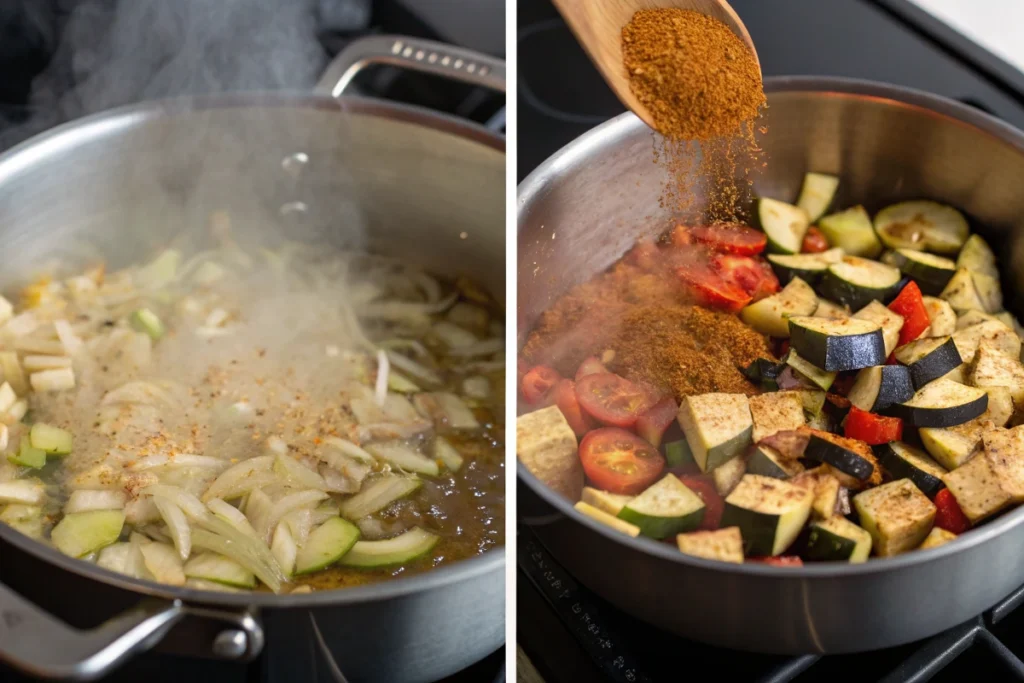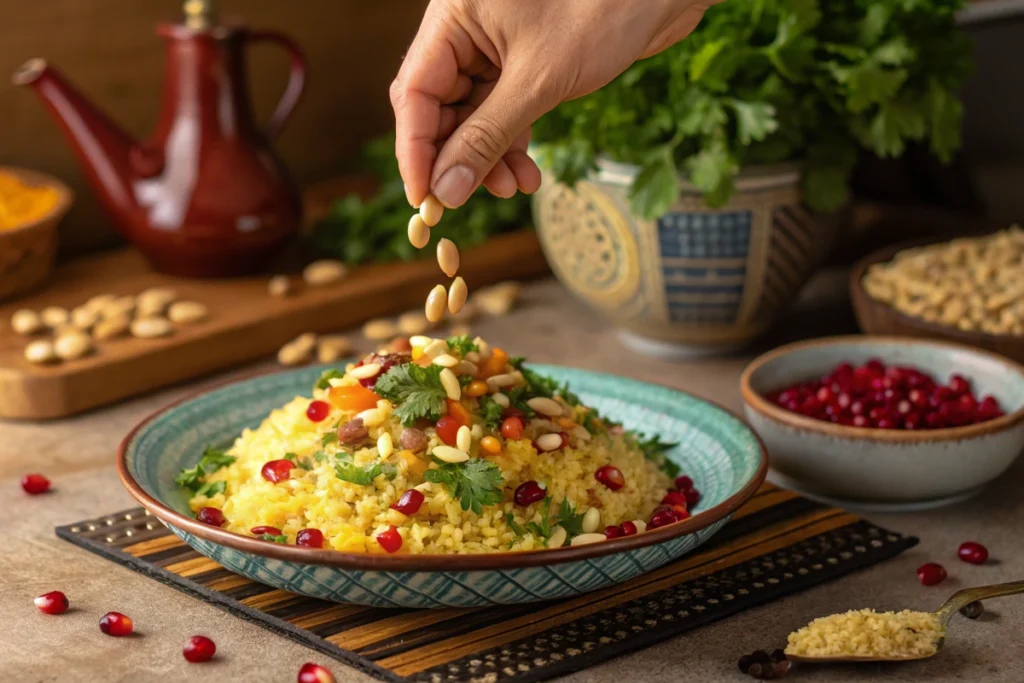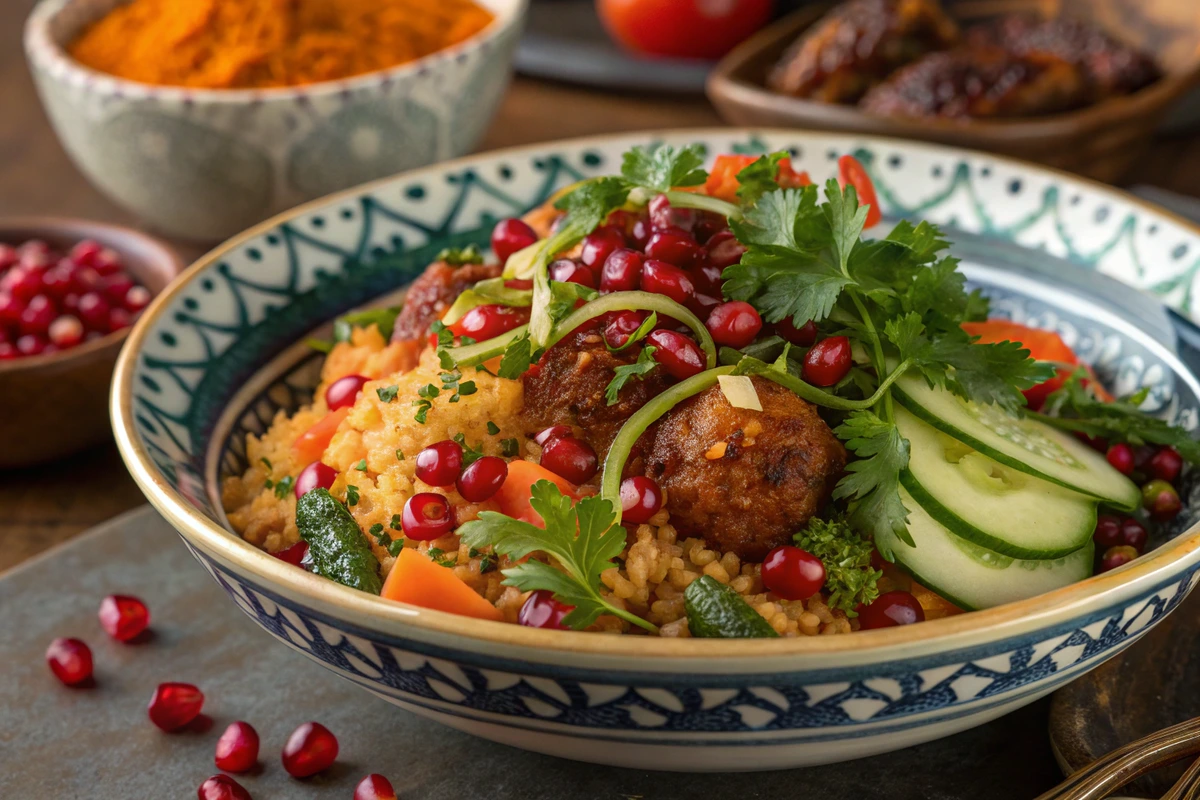Middle Eastern cuisine is a treasure trove of rich flavors, aromatic spices, and time-honored traditions. Among its most celebrated dishes is the Terra Massoud recipe, a masterpiece that blends history, culture, and gastronomy. This article takes you on a flavorful journey through its origins, key ingredients, preparation steps, and modern adaptations. Whether you’re a seasoned chef or a curious home cook, you’ll discover the allure of this iconic dish and learn how to recreate its magic in your kitchen.
Introduction to Terra Massoud Recipe
What is the Terra Massoud Recipe?
The Terra Massoud recipe is more than just a dish; it’s a story told through taste. This vibrant Middle Eastern creation is renowned for its intricate blend of sweet and savory flavors. A medley of tender vegetables, hearty grains, and aromatic spices come together in harmony, creating a feast for both the eyes and the palate.
The dish’s name itself evokes curiosity, rooted in the traditions of a bygone era yet modern enough to grace contemporary dining tables. It’s versatile, adaptable to different preferences, and irresistibly delicious—a recipe that has stood the test of time.
Cultural and Historical Significance
The Terra Massoud recipe carries a rich cultural heritage, symbolizing hospitality and abundance. It’s a dish traditionally served during celebrations, from weddings to religious festivals. Families gather around it, sharing not only food but also stories, laughter, and memories.
What makes it extraordinary is its ability to unite people. From its Middle Eastern origins to its growing global popularity, this dish transcends borders, bringing communities together through a shared love of good food.
Why It Stands Out in Middle Eastern Cuisine
What sets the Terra Massoud recipe apart is its bold use of spices and its clever layering of flavors. The dish strikes a perfect balance—each bite offers a mix of textures and tastes, from the tender grains to the tangy garnishes. Its preparation reflects the heart of Middle Eastern cooking: a celebration of simplicity elevated by artistry.
In the next section, we’ll dive into the fascinating history of the Terra Massoud recipe, exploring how it has evolved over centuries to become a symbol of culinary ingenuity.
Historical Background and Evolution
Origins of Terra Massoud Recipe
The Terra Massoud recipe traces its roots to the Middle East, a region famed for its culinary innovation and cultural richness. While the exact origins remain a topic of debate among historians, many agree that it emerged during the flourishing trade between Mediterranean and Asian civilizations. These trade routes introduced exotic spices, nuts, and dried fruits that became central to the dish’s unique profile.
Initially crafted in a small, close-knit village, this recipe symbolized the resourcefulness of its creators. They combined locally available ingredients into a dish that not only nourished but also celebrated the diversity of their land.
Influence of Mediterranean and Asian Trade
The Middle Eastern spice trade played a pivotal role in shaping the Terra Massoud recipe. As merchants carried spices, grains, and culinary ideas across continents, this dish began incorporating flavors from far and wide. For example, cinnamon and cardamom, which are signature elements today, owe their presence to these trade exchanges.
Over time, the dish evolved into a fusion of tastes that reflected both regional traditions and foreign influences. It became a culinary bridge, uniting diverse cultures in one pot.
Role in Celebratory Occasions
In its early days, the Terra Massoud recipe was often reserved for special occasions like weddings, festivals, and royal banquets. The labor-intensive preparation process and the high-quality ingredients required made it a dish of prestige.
Beyond its deliciousness, it symbolized abundance, hospitality, and joy. Sharing this dish with guests was a way of honoring them and expressing gratitude. This tradition continues today, with families proudly serving Terra Massoud as a centerpiece during festive gatherings.
Key Ingredients and Their Role
Traditional Ingredients: Spices, Meats, and Vegetables
The magic of the Terra Massoud recipe lies in its ingredients. Traditional versions often include
Grains and legumes: Nutritious staples like rice and chickpeas create a hearty foundation.
Aromatic spices: Cumin, coriander, turmeric, and cinnamon add warmth and complexity.
Fresh vegetables: Eggplant, zucchini, and tomatoes bring color, texture, and flavor.
Optional proteins: Enhance the dish with lamb, chicken, or plant-based options like tofu or jackfruit.
Fresh garnishes: Parsley and pomegranate arils add brightness and a finishing touch.
Every ingredient serves a purpose, ensuring that each bite is an experience.
Regional Variations in Ingredients
The Terra Massoud recipe has undergone many transformations as it spread across regions. Coastal communities incorporated seafood, while desert areas leaned heavily on dried fruits and nuts. Each variation tells a story about the people who created it and the resources they had at hand.
For instance, some regions favor saffron for its luxurious aroma and color, while others opt for smoked paprika to add a smoky depth. These adaptations keep the recipe alive and evolving, offering endless possibilities for interpretation.
Modern Adaptations and Substitutions
Today, the Terra Massoud recipe caters to a wide range of dietary preferences. Vegetarian versions replace meat with chickpeas or lentils, and gluten-free options substitute traditional grains with quinoa or rice. These modern twists maintain the dish’s essence while making it accessible to everyone.
Chefs and home cooks alike embrace the dish’s versatility, experimenting with ingredients to suit their tastes. Despite these innovations, the heart of the Terra Massoud recipe remains unchanged: a harmonious blend of flavors that honors its origins.
In the next part, we’ll explore the step-by-step process of preparing this timeless dish, ensuring you can bring its magic to your own kitchen.
Step-by-Step Guide to Preparing the Terra Massoud Recipe
Preparing the Base for the Terra Massoud Recipe
The first step in preparing the Terra Massoud recipe is to gather and prepare the ingredients. Chop vegetables such as eggplant, zucchini, tomatoes, and bell peppers into bite-sized pieces. If using meat, marinate it in a blend of olive oil, garlic, and spices like cumin and turmeric to infuse deep flavor.
For vegetarian or vegan adaptations, substitute the meat with chickpeas or lentils, ensuring they are rinsed and ready to cook. This step ensures all components are fresh and ready for assembly.
Enhancing Flavors with Spices in the Terra Massoud Recipe
Heat olive oil in a large pot or Dutch oven, and sauté onions and garlic until they become golden and aromatic. Then, add your chopped vegetables and cook them until softened. Sprinkle in spices such as coriander, cinnamon, and smoked paprika, allowing their fragrances to bloom.
At this stage, layering is key to achieving the rich depth of flavor characteristic of the Terra Massoud recipe. Each ingredient is seasoned and cooked to perfection before the next is added.

Cooking Techniques to Perfect the Terra Massoud Recipe
Add pre-soaked rice or your chosen grain along with vegetable broth or water. Cover the pot and let the mixture simmer gently. The slow-cooking process allows the flavors to meld beautifully, creating a rich and hearty dish.
Check occasionally to ensure the liquid hasn’t dried out, adding small amounts of broth as needed. Once the grains are tender and the flavors are well-blended, remove the pot from heat and let it rest before serving.
Final Touches and Presentation
To finish, garnish the dish with toasted nuts like pine nuts or almonds, fresh parsley, and pomegranate arils for a burst of color and flavor. Serve it straight from the pot or on a large platter to showcase its vibrant layers.
For more delicious and hearty recipes, check out our collection of Mediterranean-inspired dishes.

The Cultural Impact of the Terra Massoud Recipe
Communal Cooking Traditions
The Terra Massoud recipe is deeply rooted in the traditions of communal cooking. In Middle Eastern households, families often gather to prepare this dish together. Each person has a role, from chopping vegetables to monitoring the slow-cooking process.
This shared effort fosters a sense of togetherness and preserves the cultural stories surrounding the dish. Elders pass down the recipe, teaching younger generations the art of crafting its intricate layers.
Symbolism of Abundance and Hospitality
Throughout its history, the Terra Massoud recipe has symbolized abundance, hospitality, and celebration. Serving this dish to guests is seen as an act of generosity, reflecting the values of Middle Eastern culture. Its rich flavors and elaborate preparation make it a centerpiece for feasts and special occasions.
Global Spread and Popularity in Modern Times
Thanks to the rise of food tourism and the internet, the Terra Massoud recipe has gained worldwide acclaim. It is featured in cookbooks, food blogs, and international culinary festivals, allowing people across the globe to savor its unique taste.
Chefs and home cooks continually reimagine the dish, showcasing its adaptability while honoring its traditional roots. Its enduring popularity is a testament to the universal appeal of good food shared among loved ones.
In the next part, we’ll explore how the Terra Massoud recipe continues to evolve and adapt to modern tastes while staying true to its origins.
Modern Takes on Terra Massoud Recipe
Vegetarian and Vegan Variations
As dietary preferences shift, the Terra Massoud recipe has embraced innovative plant-based adaptations. Vegetarian versions often replace meat with hearty legumes like lentils or chickpeas, while vegan interpretations use flavorful substitutes such as jackfruit or tofu.
Despite these changes, the essence of the dish remains intact. The rich combination of spices, grains, and vegetables continues to captivate palates, offering a satisfying alternative for those seeking a meatless option.
Creative Restaurant Adaptations
In modern culinary spaces, the Terra Massoud recipe has been reimagined with unique twists to fit contemporary dining experiences. Some chefs present it as a deconstructed dish, highlighting its individual components on elegant platters. Others experiment with fusion styles, incorporating elements from other global cuisines, such as saffron-infused risotto or spiced quinoa bowls.
These creative adaptations not only keep the dish relevant but also introduce it to new audiences. Yet, even with these innovations, the original flavor profile—rooted in the traditions of Middle Eastern cuisine—remains the star of the plate.
How Food Bloggers and Chefs Reimagine It
The digital age has played a significant role in reviving interest in the Terra Massoud recipe. Food bloggers share step-by-step guides, enticing photos, and personal anecdotes about the dish’s cultural importance. Chefs showcase its versatility in cooking shows and tutorials, encouraging home cooks to try their hand at this Middle Eastern classic.
This online presence has not only popularized the recipe but has also preserved its legacy, making it accessible to food lovers everywhere.
Nutritional Information and Health Benefits
The Terra Massoud Recipe is a delicious and nutrient-packed dish, offering a perfect balance of complex carbohydrates, protein, and fiber. It’s low in sugar and saturated fats, making it both satisfying and healthy.
Here are some key nutritional highlights of the Terra Massoud recipe:
- High in complex carbohydrates: Comes from grains like rice and fresh vegetables.
- Great source of protein: Includes lean meat like chicken or lamb, or plant-based options like chickpeas.
- Rich in fiber: Packed with vegetables and whole grains that support digestion.
- Low in sugar and saturated fats: Ideal for heart health and weight management.
The Terra Massoud Recipe is a well-rounded meal, perfect for those looking to enjoy tasty food while maintaining a balanced diet. Its nutrient-rich profile makes it great for weight management and overall health. Adding this recipe to your regular meals is a flavorful way to boost your nutritional intake!
Nutritional Information (Per Serving)
Based on the ingredients used in the Terra Massoud recipe, here’s the breakdown for one serving:
| Nutrient | Amount per Serving |
|---|---|
| Calories | 420-480 kcal |
| Protein | 18-22 g |
| Total Fat | 12-16 g |
| Saturated Fat | 2-3 g |
| Carbohydrates | 55-65 g |
| Dietary Fiber | 6-8 g |
| Sugars | 5-7 g |
| Sodium | 400-500 mg |
This nutritious dish provides a great balance of macronutrients while being naturaly rich in vitamins and minerals, thanks to its vegetables and spices. A wholesome and flavorful choice for your next meal!
Frequently Asked Questions
What is the Terra Massoud recipe?
The Terra Massoud recipe is a vibrant Middle Eastern-inspired dish, typically featuring saffron-infused rice layered with tender vegetables, toasted nuts like pine nuts or almonds, and sweet pomegranate arils. It’s finished with a garnish of fresh parsley and often served on a large platter to showcase its beautiful presentation. This dish is celebrated for its bold flavors, aromatic spices, and stunning visual appeal.
What Makes Terra Massoud Unique Compared to Other Middle Eastern Dishes?
The Terra Massoud recipe stands out for its harmonious balance of sweet and savory flavors, achieved through its use of aromatic spices, tender grains, and vibrant garnishes. Its elaborate preparation process and rich cultural significance set it apart as a culinary masterpiece.
Can It Be Made Gluten-Free or Vegan?
Absolutely! The Terra Massoud recipe is highly adaptable. For a gluten-free version, simply substitute the traditional grains with options like quinoa or gluten-free couscous. Vegan versions can use plant-based proteins or legumes in place of meat, ensuring the dish remains hearty and flavorful.
What Are the Best Pairings for This Dish?
The Terra Massoud recipe pairs beautifully with Middle Eastern sides such as hummus, baba ghanoush, or a fresh cucumber and tomato salad. A dollop of yogurt or a drizzle of tahini also complements the dish’s robust flavors.
How Do You Store Leftovers Without Losing Flavor?
To maintain the dish’s integrity, store leftovers in an airtight container in the refrigerator for up to three days. When reheating, add a splash of broth to restore moisture and keep the flavors vibrant.
This FAQ section aims to address common queries about the Terra Massoud recipe, ensuring that both novice cooks and culinary enthusiasts can confidently enjoy this timeless dish.
Conclusion
The Terra Massoud recipe is more than just a dish; it’s a celebration of Middle Eastern culture, history, and culinary art. From its origins rooted in trade and tradition to its modern adaptations that cater to diverse dietary needs, this recipe has proven its timeless appeal.
Its rich flavors, intricate preparation, and cultural significance make it a standout in global cuisine. Whether enjoyed in its traditional form or reimagined for contemporary tastes, the Terra Massoud recipe continues to unite people through the simple yet profound joy of sharing good food.
So why not give this iconic dish a try? Dive into the world of bold spices, tender grains, and vibrant garnishes, and experience the magic of a recipe that has delighted palates for generations.

